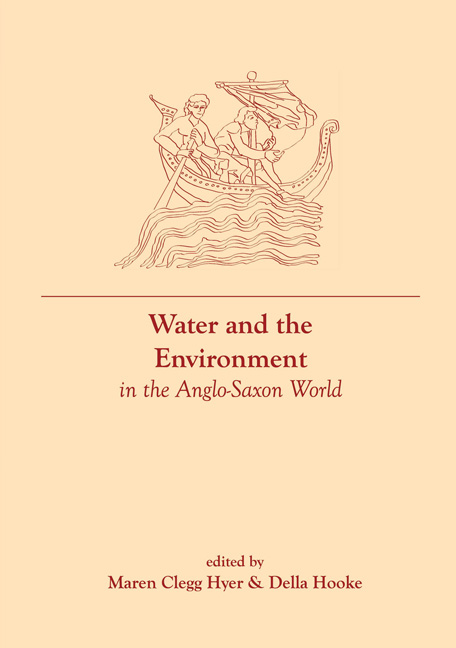Book contents
- Frontmatter
- Dedication
- Contents
- List of Illustrations
- List of Tables
- List of Contributors
- Introduction
- 1 From Whale's Road to Water under the Earth: Water in Anglo-Saxon Poetry
- 2 Water in the Landscape: Charters, Laws and Place Names
- 3 Fens and Frontiers
- 4 Marshlands and Other Wetlands
- 5 Rivers, Wells and Springs in Anglo-Saxon England: Water in Sacred and Mystical Contexts
- 6 Food from the Water: Fishing
- 7 Inland Waterways and Coastal Transport: Landing Places, Canals and Bridges
- 8 Watermills and Waterwheels
- 9 Water, Wics and Burhs
- Notes
- Suggested Reading
- Index
9 - Water, Wics and Burhs
- Frontmatter
- Dedication
- Contents
- List of Illustrations
- List of Tables
- List of Contributors
- Introduction
- 1 From Whale's Road to Water under the Earth: Water in Anglo-Saxon Poetry
- 2 Water in the Landscape: Charters, Laws and Place Names
- 3 Fens and Frontiers
- 4 Marshlands and Other Wetlands
- 5 Rivers, Wells and Springs in Anglo-Saxon England: Water in Sacred and Mystical Contexts
- 6 Food from the Water: Fishing
- 7 Inland Waterways and Coastal Transport: Landing Places, Canals and Bridges
- 8 Watermills and Waterwheels
- 9 Water, Wics and Burhs
- Notes
- Suggested Reading
- Index
Summary
quorum metropolis Lundonia ciuitas est, super ripam praefati fluminis posita, et ipsa multorum emporium populorum terra marique uenientium
Its chief city is London, which is on the banks of that river [the Thames] and is an emporium for many nations who come to it by land and sea.
Introduction
There was no doubt in the mind of Bede that London was both a city (civitas) and a trading place (emporium) in the early eighth century, a river port that was the destination for long-distance trade ‘by land and sea’. Towns, trade, navigable rivers and seaways were closely associated across western and northern Europe in the early medieval period. The aim of this chapter is to investigate those connections and explore the wider role of water in the urban environment and in the everyday lives of Anglo-Saxon town dwellers.
There is an extensive literature on many aspects of Anglo-Saxon towns, but despite many decades of research, basic questions remain about urban origins and urban economies. Martin Biddle defined a research framework for Anglo-Saxon towns in 1976 which remains relevant today. The documentary evidence is fundamental but limited in quantity, so it is through detailed surveys of individual towns and archaeological excavations that knowledge has advanced. One focus of this chapter is the location of many Anglo-Saxon towns on navigable rivers. The reasons for such sitings included military strategy and new administrative arrangements, but through the Anglo-Saxon period it was access to navigable rivers and the sea that was important for economic development. Rivers and seaways formed the principal trade routes of the early medieval period, and it was the successful exploitation of these routes that was key to the economic prosperity of towns at this period.
The study of towns in Anglo-Saxon Britain must take into consideration the extensive urban landscape of Roman Britain. Many Roman towns had been established on navigable rivers, at fordable or bridgeable locations, and the larger towns had stone walls. At the outset of the Anglo-Saxon period the Roman towns lay abandoned, in many cases after a long period of decline. Urban life had ended in any meaningful sense, but there was an impressive legacy of urban ruins.
- Type
- Chapter
- Information
- Water and the Environment in the Anglo-Saxon World , pp. 187 - 201Publisher: Liverpool University PressPrint publication year: 2017



